Turnstiles: Brawn, Brains or Both
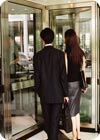
Technology can be added to revolving doors to increase security and cut down on tailgating.
From Chicago’s Sears Tower to Madison Square Garden and from the Chrysler building to Northrop Grumman, chief security officers covering high-rise lobbies, stadiums and plant entrances all share a business mission: a welcome that blends a certain level of security with a certain desired look.
No doubt, security is key in these entry and exit points. It turns out that turnstiles – from ballpark mechanical traditionals to architecturally friendly opticals to outdoor modular standalones and turnstiles built into guardhouses -- can achieve that balance of brawn, brains or a mixture of both.
Today turnstiles are more than a barrier or a head counter. They are becoming more secure and less obtrusive by blending in with building aesthetics, providing critical tailgate detection and fully integrating with existing and new-age access control systems. But before building owners or security managers chose turnstiles, they should ask themselves some questions to ensure that the solutions they select are the best for the job.
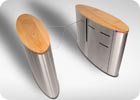
Some turnstiles can mirror the high tech look of a lobby or office entrance. Photo courtesy Smarter Security Systems
ARE TURNSTILES NECESSARY IF SECURITY OFFICERS ARE ALREADY BEING USED?
Many facilities use security officers in their lobbies, citing turnstiles as an unnecessary addition. This could be a costly mistake in buildings where lobbies are large and pedestrian throughput is high. Using turnstiles to monitor pedestrian flow allows security officers to devote their time and energy to focusing on “the exception,” which could be suspicious behavior or packages that require closer inspection. With turnstiles handling the regular traffic flow, officers can devote full attention to these abnormal circumstances without jeopardizing access control procedures for other pedestrians.Turnstiles can also expedite traffic flow during peak hours. Depending on the access control system, optical turnstiles can be used to help prior individual access within a second or two. In buildings that require identification checks, this avoids the long lines that can occur at peak traffic times when the traffic flow is simply too high for security officers to review each card or badge as quickly as needed. Security or reception can issue temporary passes – with expiration dates – for access through the turnstiles. The Hall of the States in Washington, D.C., which has scores of visitors every day to state offices in the building, uses the approach.
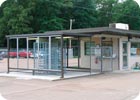
Turnstiles can come with or custom added to modular buildings for guardhouses and parking lot and garage access. Photo courtesy Porta-King
CAN TURNSTILES FIT SPECIFIC BUILDING AESTHETICS OR ARCHITECTURAL REQUIREMENTS?
Optical turnstiles in particular can be custom designed to blend into any building’s aesthetics. Mid-sized, canister style, barrier arm and non-barrier arm optical turnstiles provide a variety of options to fit linear or even circular open lobby applications. Custom colors and finishes including granite, wood, glass and stainless steel can be used to help turnstiles become a part of a building’s aesthetics—instead of competing with them. This correlates to less noticeable and less intimating access control.Customized turnstiles can also help keep access control within strict building guidelines, such as New York City’s Landmarks Preservation Commission regulations.
Tishman Speyer Properties installed turnstiles in a 16-building project encompassing Rockefeller Center and the Chrysler building. The goal for these high-profile New York City landmarks: to enhance building security while preserving architectural integrity. With millions of occupants and visitors entering and exiting each year, Rockefeller Center and the Chrysler building installed barrier arm optical turnstiles (from Designed Security) to manage high throughput pedestrian traffic. While meeting the security demands of these high-profile buildings, the turnstiles were customized with finishes and configurations fitting each building’s unique architectural era and aesthetics to pass Landmarks Preservation Commission regulations.
CAN TURNSTILES BE INTEGRATED INTO CURRENT ACCESS CONTROL SYSTEMS?
Installing turnstiles does not necessarily mean a new card reader, alarm system or control panel. Most are fully compatible with major card reader and access control technology. And most turnstiles are versatile enough to comply with various access control building requirements such as the Americans with Disabilities Act.For example, New York University uses an elegant architectural security barrier (from Automatic Control Systems) in conjunction with its access control system to provide the ADA compliant entrance. The turnstile paddles swing 90° in both directions providing for safe and easy passage for both the handicapped and individuals requiring assistance.
WHAT ABOUT VISITOR MANAGEMENT?
Turnstiles can be a key component of one of the fastest-growing priorities for building security: visitor management. Paper systems to log visitor traffic are becoming a thing of the past. The new world: visitor management as fully integrated, fully electronic systems. Turnstiles can be fitted with multiple card readers to handle both employee and visitor traffic separately. Once visitors register, they receive badges with special barcodes embedded that will expire at a set time. When the badges expire, visitors can simply throw them away. Alternatively, some turnstiles can be fitted with card-collectors to identify and keep one-time use visitor badges.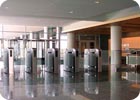
There’s beauty in the brawn of optical turnstiles so that business lobbies can reflect the tenants’ aesthetics. Photo courtesy Automated Control Systems
DO TURNSTILES PROTECT AGAINST TAILGATING?
Both mechanical and optical turnstiles have effective tailgate-control capabilities. With mechanical turnstiles, people can be screened by the use of conventional access control devices, i.e. proximity card readers, biometrics, etc. Audible and visual annunciators can then communicate walkway usage and access control violations to the users.Optical turnstiles provide additional tailgate detection. The optical sensors are set to allow one person to enter for each valid ID used. They can detect, deter and report attempts to enter without a valid card or by tailgating behind authorized personnel.
Revolving doors also have been juiced up for higher level security. For example, StereoVision (from Boon Edam) is security revolving door technology designed to enhance the effectiveness of the revolving door by preventing piggybacking, tailgating and unauthorized entries. The system recognizes shapes, sizes and volume in three dimensions, and can determine if two people are attempting to enter in one compartment.
Security video can also integrate into turnstiles and revolving doors by having a dome camera, for instance, swing to and grab images at an alarm.
WHAT ABOUT SECURITY FOR UNATTENDED LOCATIONS?
Turn to full height turnstiles. Turnstiles aren’t just for busy building lobbies. Full height turnstiles are ideal for indoor and outdoor applications where added security and high pedestrian traffic are priorities, including unattended locations in a facility where only authorized employee access is allowed. While providing a true access control barrier, many of these units will still control high throughput traffic flow of up to 20 people per minute per turnstile. Most are also compatible with any major access control system.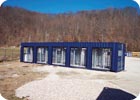
“Play and play” outdoor access points, such as the MAC, contain guardhouses, high security turnstiles, access control technology as well as surveillance cameras, metal detection and explosive detection equipment.
WHAT ABOUT USE OUTDOORS?
There are a variety of solutions.Many power, petroleum and chemical plants use the MAC (Modular Access Control) portals (from Modular Security Systems, Inc.). These “turnkey” access control points contain guardhouses, high security turnstiles, access control technology as well as surveillance cameras, metal detection and explosive detection equipment. It is basically a “plug-and-play” access gate that comes equipped with state-of-the-art ID verification such as iris scanners, fingerprint readers, palm readers or simple proximity card readers. The solution is rapidly deployable. Many North American plants have contractor entry gates or contactor parking lots that are not equipped with turnstiles or needed access control. Although initially developed with site security in mind, such portals are also being used for managing payroll when loaded with gate-to-paycheck software or when a plant is manning up for a large capitol or turnaround maintenance project and expect an increase in manpower for a limited amount of time.
Modular guardhouses and shelters can also come with turnstiles. For example, firms such as B.I.G., Porta-King and Par-Kut International have booths and shelters that come with turnstiles for more secure parking lot access or can customize with an added turnstile.
Looking for a reprint of this article?
From high-res PDFs to custom plaques, order your copy today!




